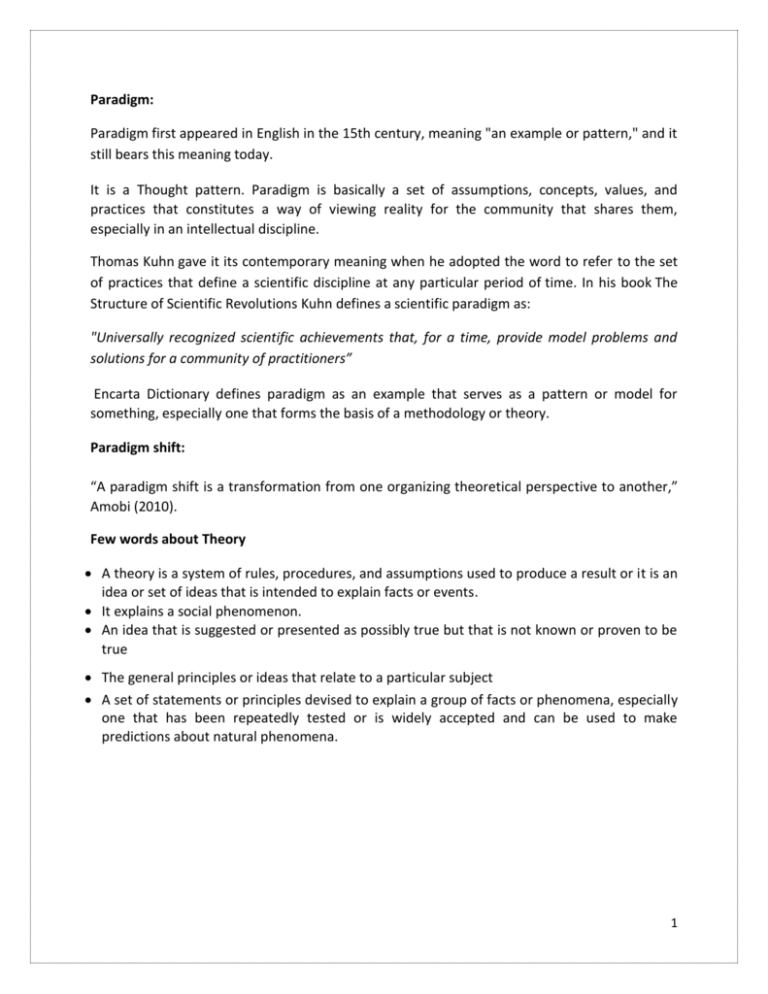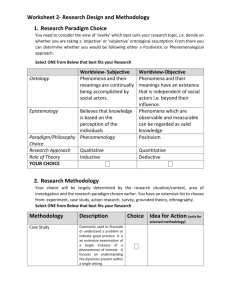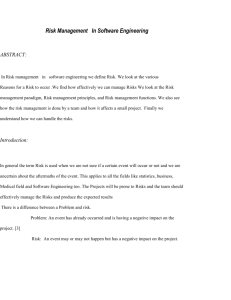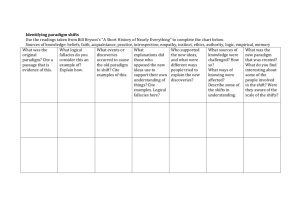Paradigm, Thoery
advertisement

Paradigm: Paradigm first appeared in English in the 15th century, meaning "an example or pattern," and it still bears this meaning today. It is a Thought pattern. Paradigm is basically a set of assumptions, concepts, values, and practices that constitutes a way of viewing reality for the community that shares them, especially in an intellectual discipline. Thomas Kuhn gave it its contemporary meaning when he adopted the word to refer to the set of practices that define a scientific discipline at any particular period of time. In his book The Structure of Scientific Revolutions Kuhn defines a scientific paradigm as: "Universally recognized scientific achievements that, for a time, provide model problems and solutions for a community of practitioners” Encarta Dictionary defines paradigm as an example that serves as a pattern or model for something, especially one that forms the basis of a methodology or theory. Paradigm shift: “A paradigm shift is a transformation from one organizing theoretical perspective to another,” Amobi (2010). Few words about Theory A theory is a system of rules, procedures, and assumptions used to produce a result or it is an idea or set of ideas that is intended to explain facts or events. It explains a social phenomenon. An idea that is suggested or presented as possibly true but that is not known or proven to be true The general principles or ideas that relate to a particular subject A set of statements or principles devised to explain a group of facts or phenomena, especially one that has been repeatedly tested or is widely accepted and can be used to make predictions about natural phenomena. 1 Paradigms in Mass Communication The Powerful Effect Paradigm During the dominance of the print medium, The All Powerful Media Theory was in place. Hitler’s use of media to persuade army’s minds. Media Effects Studies was started. Magic bullet theory/Transmission belt theory. Hypodermic needle theory was presented during this era. It is likened to a bullet released with immediate and direct effects towards audience. Audience members were considered as weak, passive and could be manipulated. This theory was popular in the nineteenth century. The media was believed to possess the powers to manipulate people’s behaviors. War of the world. The Limited Effects Paradigm The second phase in a more optimistic perspective starts considering the limitations of mass communication. This era known as The Limited Effects Paradigm emerged in 1938. Further research by Paul Lazarsfeld along with his colleagues on the 1940 Presidential election in Erie County, Ohio revealed that the power of the media was limited and this was due to individual differences. E.g. Two Steps Flow Model and Limited Effects Theory. Media is not as powerful as it was conceived in past. It is enjoying limited effects because there are different people involved during the communication process like opinion leaders. Lazerfeld emphasized on scientific methodology and used survey and experimental methodology to test his study. The Moderate Effects Paradigm During 1970 to 1980, the third phase took center stage. This is a general step backward to the first phase with some relevant differences. This is the Moderate Effects Paradigm. Media is considered powerful but their effects are no longer immediate but cumulative. E.g Play Theory, Uses and Gratifications Theory, Spiral of Silence and Agenda Setting Theory. All Powerful Media Effects 2 “With the birth of television and new technologies, mediating factors such as church, family and school began to lose their traditional socializing role for many people,” Amobi (2010). It has therefore become increasingly difficult to ignore the media and their increasing influence. This is referred to as The All Powerful Media revisited as named by Okunna (1999). Media is powerful having strong effects on audience but audience is active now and they can react to media messages. Like uses and gratification theory. 3









